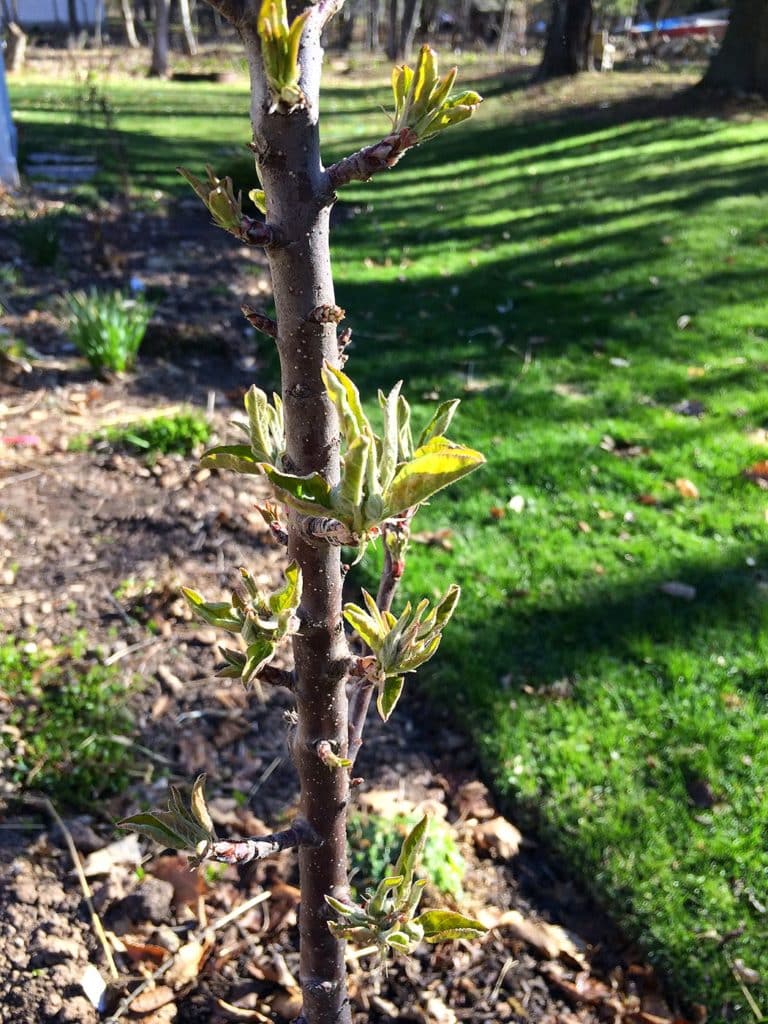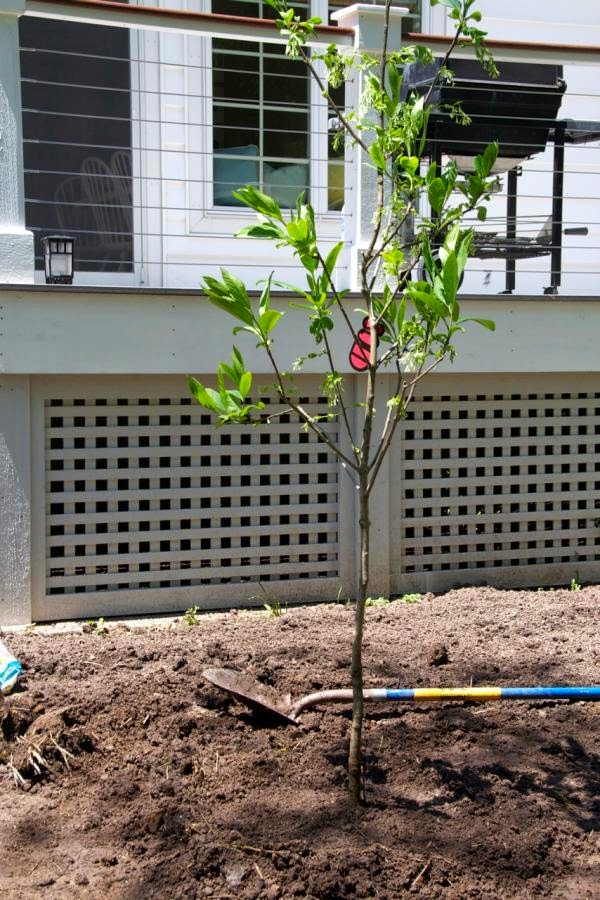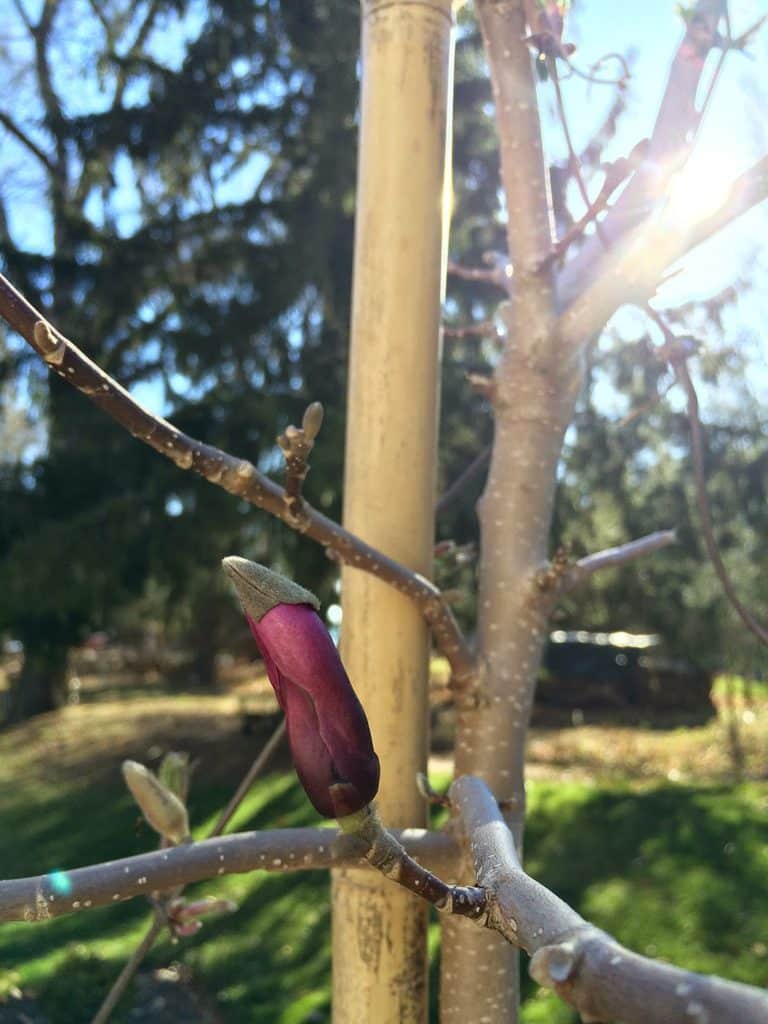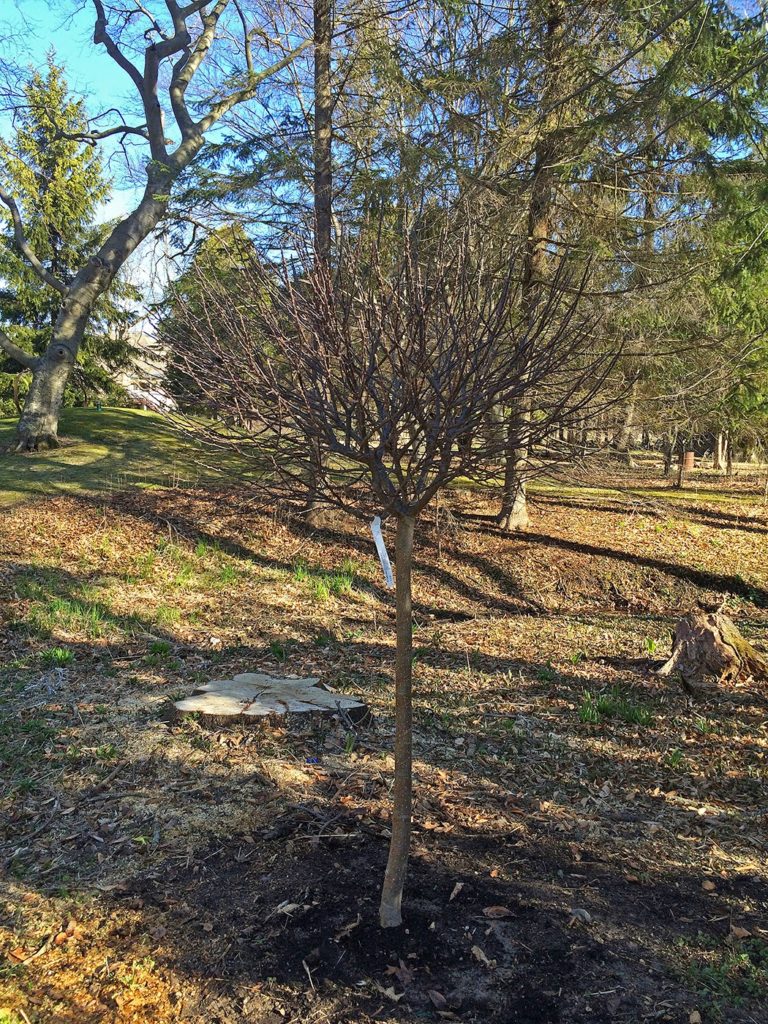I garden in cycles. Every couple years, I create a new garden area (i.e. last year I redid the back yard), which is a ton of work, and then the next year I think to myself, “Oh I’ll just do maintenance this year.” What really ends up happening is that I just seem to buy with somewhat reckless abandon because I don’t have a specific plan or “budget” (that word is always in quotes when it relates to my garden) to guide me.
 |
| From afar, the columnar apple looks like a big stick, but up close there are signs of life to come. |
In addition to the ridiculous number of dahlias I bought over winter, many of which are currently in pots in my house as I wait for them to sprout, I also went a little tree crazy at the nursery a couple weekends ago. I brought home one tree that fit in my car: a columnar apple. This replaces a sickly ‘Fine Line’ Buckthorn that suffered the fate of living in shade for too long and it just couldn’t recuperate. By the way, I love the idea of planting small fruit trees right in the middle of an ornamental garden because I think they are beautiful. An apple blossom might be the most romantic flower in the world.
 |
| That’s what the fringe tree looked like when we planted it back in 2011. |
 |
| And here it is now in it’s new location, looking quite shrimpy with the big beech in the background. |
The fringe tree off the deck has been moved. It can’t say I didn’t warn it. Because I did. Of all the small trees in our yard, that one takes center stage because of its proximity to the deck and prominence in the back yard. I planted it four years ago and I feel like I’ve been more than a little patient with it. Sure, it’s grown a little, but it’s still sort of spindly. Worse, it gives me approximately two lame flowers a year and I’ve not seen any sign of that number getting larger over the years. Sorry, fringe tree, you’re going to have to put on a better show than that if you want that coveted spot.
Yes, part of this is my impatience coming through, but more and more, I just don’t have a lot of hope for this tree. But it’s not the end of the road for the fringe tree. He (or she, and that may be part of the problem as far as the flowering goes) has been moved to a lovely little spot by the creek, which is actually sunny now, thanks to the removal of a couple of very large trees last year.
 |
| With luck, we will see a few flowers on ‘Ann’ this year. |
In its place is Ann. Magnolia ‘Ann,’ that is. She’s part of the “Little Girl” series of magnolias that stay quite compact but put on the kind of show you’d expect from a magnolia. They do tend to be a little shrubby, which is not what I’m looking for in that spot, but I was able to find a tree-form ‘Ann’ that will allow the canopy to hover a few feet off the ground. Truth be told, I really wanted ‘Jane,’ which has pink blossoms that open to white, but it wasn’t available in the tree form and I felt that was more important.
I will admit, when I got this tree home I wondered what I was thinking when I chose it (honestly, I was exhausted and they only had two left to choose from). It doesn’t have great shape (it has almost no branches on one side), but once you’ve borrowed a truck to drag a tree home via a one-hour drive, you’re pretty much planting that sucker. Four years from now we might be in the same place, but for now I’m giving it a chance and hoping for the best.
We also added a crabapple, again in the newly sunny area made possible by the removal of diseased or damaged trees last year. Not only will it offer some additional screening from our neighbors to the north, it will be a perfect focal point from our living room window.
To be honest, crabapples scare me a little. Is there any other tree more well-known for its disease problems? And for every gorgeous crabapple I’ve seen, I can think of two that look terrible and are badly in need of a restorative pruning. I started my search for the right tree by looking for disease resistance and size. I also didn’t want one that would get too horizontal.
 |
| It looks like very little so far, but hopefully it will become a star in the yard. |
I’m fortunate to have an excellent tree nursery near me that has great information online. In their plant reference guide they have a chart on crabapples and I used it to narrow down my choices to two: ‘Coralburst’ and ‘Royal Raindrops,’ both of which have excellent disease resistance. Ultimately we went with ‘Coralburst’ just because we liked the flower color better.
All of the trees are planted and none of them look like anything yet because they’ve yet to flower or leaf out, which is why the pictures (admittedly hastily taken early in the morning), but I’m hoping the early-season move will ultimately be beneficial to them by shocking them less by the move.
And it’s nice to have it done. It’s always fun to get a tree, but planting a tree is a chore.



5 Responses
Trees are such an investment, even more in time waiting for growth and results than in $$. I've planted quite a few this year and last, and it's always so hard to wait to see what it will look like as it matures (if it matures and doesn't simply die for some reason, known or unknown). I wish you the best of luck in your results. (I like these updates about your own gardens the best of all your posts — thanks for letting us know what you're doing and the improvements you're making!) -Beth
I love the look of the magnolia. I have a Ginkgo that is that way and now that it is older, I really like the asymmetry. We have an old crab that tends to lose its leaves midsummer, but it is such a beautiful shape that I don't let it bother me.
It's going to be tree shopping year too after the loss of a Rose of Sharon and a Witches Broom (don't know the real name of this). I think I'll replace the Rose of Sharon as it seems to be the unofficial shrub of the town – it seems everyone has one. As for the other one, I'm not sure. It sits in a garden which is seen from the kitchen and attracts a lot of birds. So I need to replace it with something that will grow to about 12' but not shade the entire area. Any suggestions?
I moved onto a property that had a young Jane magnolia on it two years ago. It was scraggly, had powdery mildew, and was just overall anemic looking. That fall when I arrived I treated it for the powdery mildew and drove some tree fertilizer stakes in around the drip line.
Come spring, it responded with a burst of growth that surprised me and a moderate amount of blooms. No powdery mildew at all that year. Again, I used tree fertilizer spikes about mid-spring.
This last fall I again drove fertilizer stakes in around its (expanded) drip line and trimmed it hard. I envision a moderate tree instead of the leggy and unattractive bush it had become.
This spring I was rewarded with an amazing amount of bloom on a much more attractive and shapely (short-ish, about 12' tall) tree. The leaves are about to bust out and I think this will be a great year for it.
I do believe the fertilizer spikes made a huge amount of difference, as well as a discriminating trim.
Last year my tree guys did an injection into my crabs for apple scab which is very different than the usual fungicide spraying, which to me seems ineffective at the very tops of my large crabapples….I'm hoping the injection did the trick…..but would definitely like to hear how your crabapple variety holds up to disease.